Value Streams and Digital Transformation

Technology is sprinting forward at breakneck speeds, consuming everything along its path.
With each passing day, the data economy, mass automation, and transformative technologies like AI and cloud systems are growing exponentially. So, too, are the innovative organizations that are leading the charge.
This ever-increasing pace of change is splitting the world in two, causing a widening gap between organizations that embrace change and those that resist or are slow to adapt. Associations are particularly at risk of ending up on the wrong side of this divide.
Member-based organizations are driven by economic and technological changes. In this dynamic space, you must be one step ahead to create even more value for members. As an association leader, you must transform your organization into a digital driver to continually advance member interests.
It’s through value stream management (VSM) that your organization can scale your value propositions and weaponize digital transformation. VSM allows you to quickly adapt to the latest trends and drive process flow and innovative value creation through value-based IT investment.
And with the pace of digital disruption, VSM practices like value stream mapping is vital to maintaining a presence in face of continuous change.
What is a value stream?
A value stream is the way value flows through an organization. It involves the sequence of actions required to meet specific audience needs.
In the association space, a value stream includes the set of actions taken to deliver a service, product, event, e-learning course, certificate, or another value capability to members or other target audiences.
It also includes everything necessary to provide product and service features, availability, cost, performance, and other dimensions of value. In other words, the capabilities within a value stream can be external (member-centric) or internal, flow-based.
The key point here is that IT is strategic and tied to a strategic plan.
Your organization's strategic objectives are realized through your value streams. Your key business capabilities enable these value streams. And your IT programs serve to enhance these key capabilities. Everything is aligned.

What is the purpose of value stream mapping?
The purpose of value stream mapping is to optimize the flow of value through an organization.
It’s a practice within Value Stream Management (VSM) that helps to support your IT programs and turn them into digital business drivers. This approach puts your members at the center of innovative value creation.
Value stream mapping allows you to answer questions such as, “how can we deliver value to members through innovation – without delay, but with improved quality and lower costs?”
VSM practices look at your workflows and processes from a macro level. The goal is to identify where the flow in a value stream is slowing down and constraints interfering with the speed and quality of value delivery. With this insight in hand, you can initiate corrective actions to optimize the end-to-end value stream via a strategic IT roadmap.
How is value stream mapping performed?
Essentially, value stream mapping entails laying out a visual roadmap of your value streams. Map your value streams to key organizational capabilities, then to IT processes, and finally to an actionable, investment-based IT strategy roadmap that drives value creation.
Step 1: Develop descriptions for your current value streams.
Whenever possible, it’s wise to group your offerings into product/service families.
Common value streams for professional associations relate to recruitment and engagement, member services and affiliate support, and advocacy and lobbying.
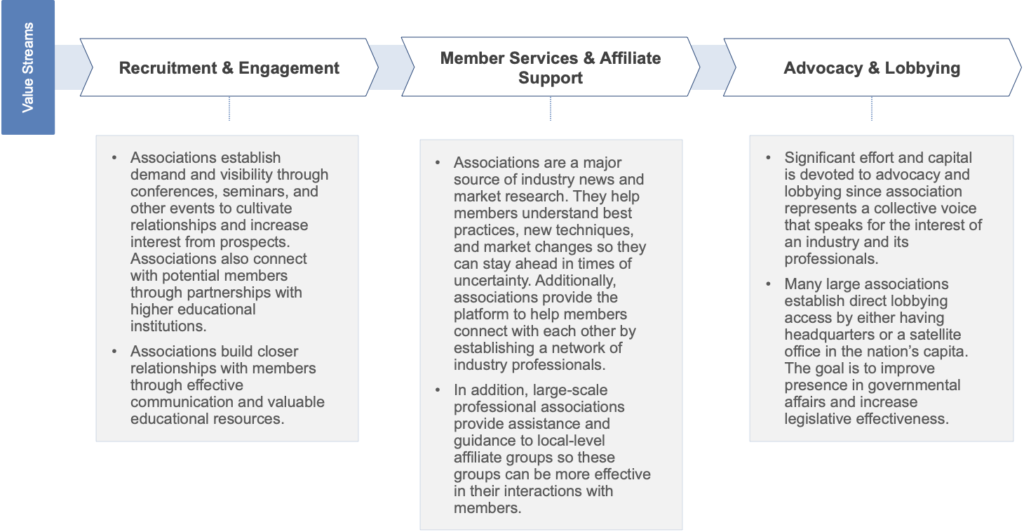
Step 2: Create a key capabilities map.
Business capability maps allow you to map your “defining, shared and enabling” capabilities and competencies to your value streams.
This step is about gaining an overview of the major processes and actions in the value stream. It involves higher-level analysis, rather than “point-by-point” value stream mapping.
Through key capabilities mapping, you can identify "stream items” for further analysis. Stream items or “flow elements” are the units of value that move through the value stream. This visualization and strategic mapping process underscore four flow elements.
- Features – member requirements, user stories
- Defects – bugs, helps desk incidents
- Risks – vulnerabilities, regulations
- Debts – tech debt, upgrades
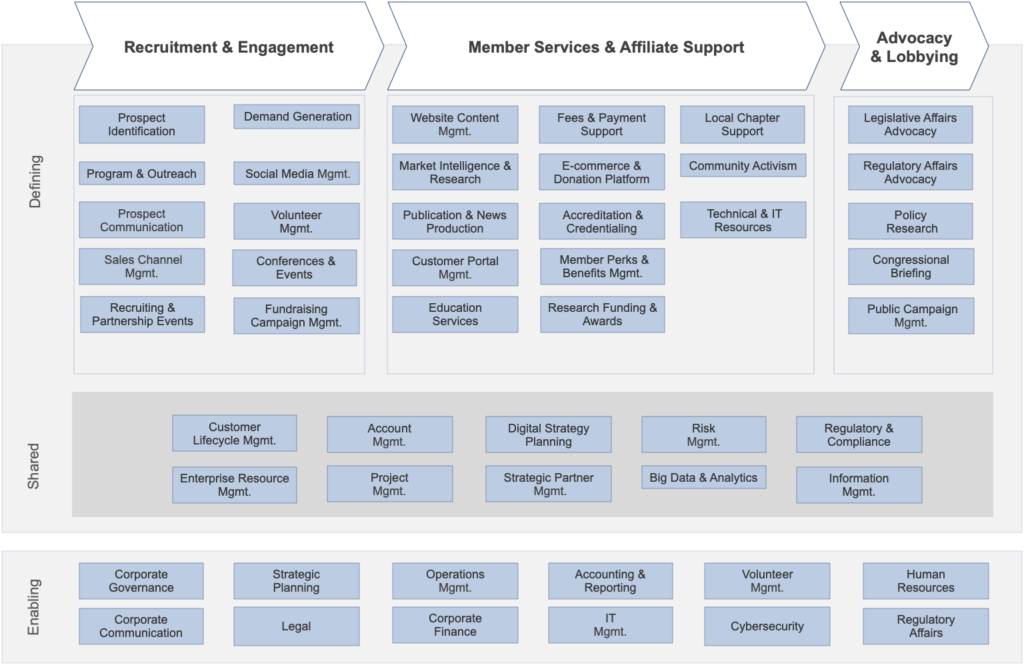
Step 3: Define your key capabilities.
Defining your key capabilities requires you to analyze each of your product/service groupings, one by one. This helps identify non-productive activities in the value chain. Consider the nitty-gritty specifics and needs of your members.
Your analysis should include “flow metrics.” These metrics tell you how efficient a value stream is, and ultimately improve the flow through value stream networks.

Look at the trends within these metrics as well. This step in the value stream mapping process allows you to identify non-productive activities and "no-flow elements.”
It essentially gives you a clear indication of whether the flow of your value stream is healthy and can support your desired business results.
Be sure to incorporate data-driven insight from every stage of the value stream, from planning to operation. Address factors such as lead/production time, highest cost, new product, highest revenue, and volume.
Use this illustrative example as a reference:
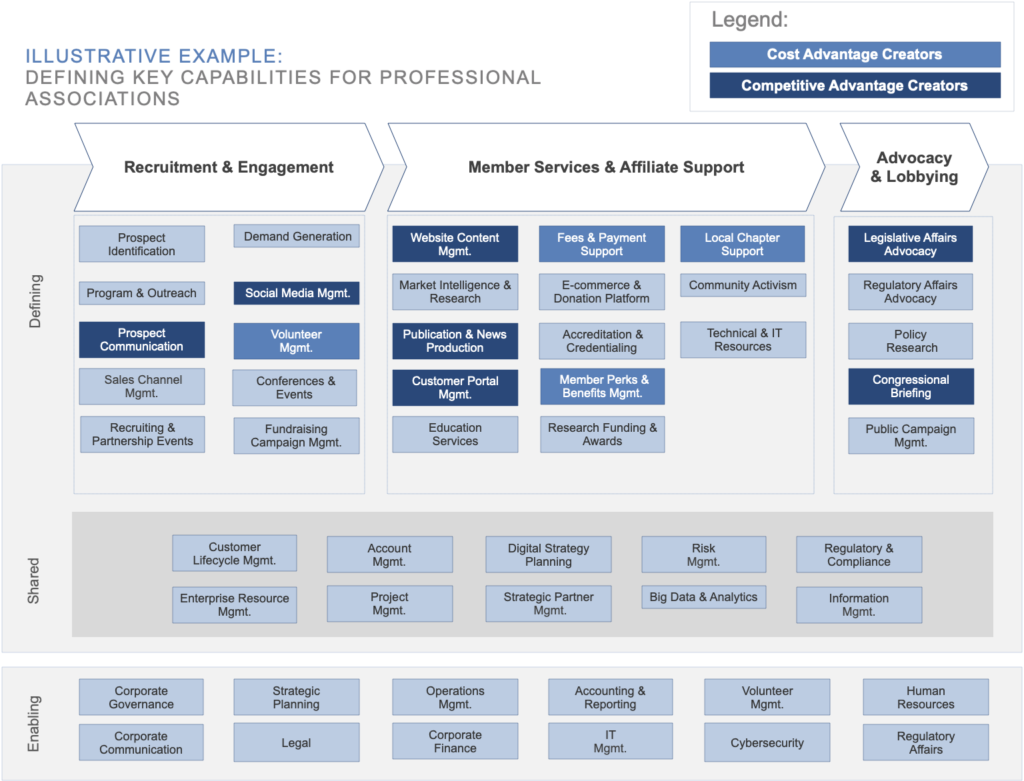
Everything in a value chain isn’t necessarily a core competency of your organization though. Your organization can develop some capabilities over time.
For example, your processes for change management and continuous improvement can be achieved as your organization and governance practices mature.
Step 4: Create a strategy map.
Strategy maps leverage visualization and mapping to plan out a set of actions to increase the speed of the value stream.
Consider what value IT is bringing to your strategic objectives in order to meet the demands and expectations of your members.

Step 5: Assign accountability and responsibility for value capabilities.
When determining accountability and responsibility, consider the availability of staff, access to technical expertise, and critical knowledge for all stakeholders involved. Focus on supporting internal balance and sustainability of value chains.
The visual below illustrates how you'd assign which business unit (aka department in your association) is accountable and/or responsible for each key capability. In the association world, supporting business units are your member services department, billing support, events and conferences, research and content, legislative affair, finance, and IT. Illustrate which supporting unit/department is:
- Accountable for the delivery of a capability.
- Responsible for the delivery of a capability.
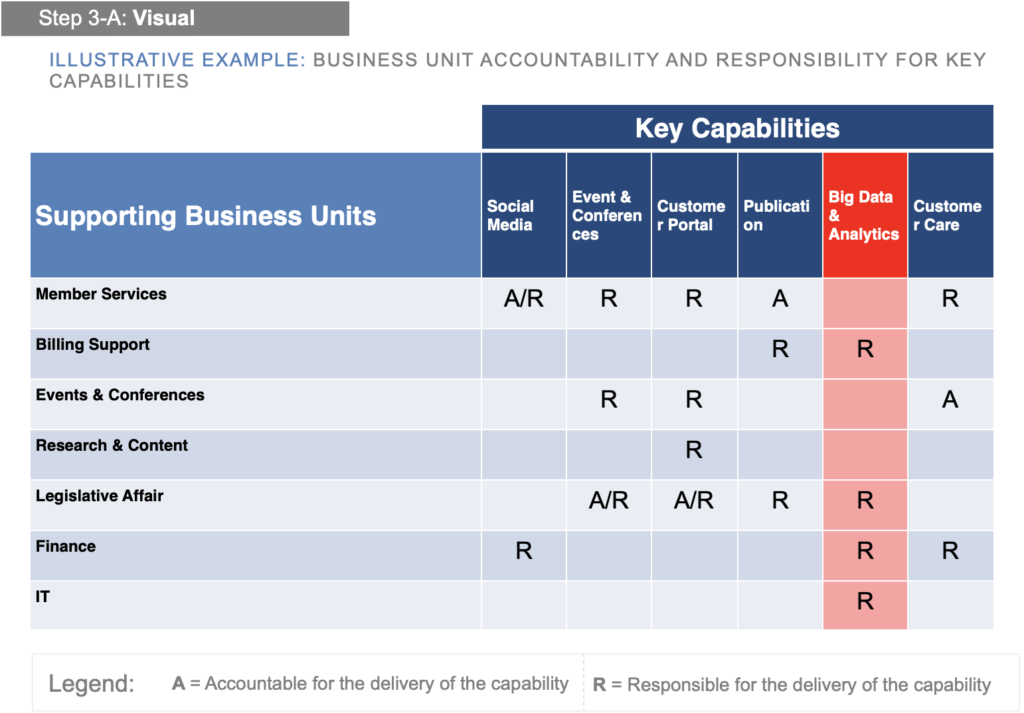
Include applicable business partnerships as well. Does your organization outsource any value capabilities? Do you have any strategic partner relationships in your value stream network?
More and more organizations are forming strategic alliances because of price to quality ratio, ease of upscaling, and enhanced access to specific capabilities and required skills.
In an ideal value stream network, these business alliances drive down costs, create competition, and improve the quality of products and services.
Step 6: Assess the level of process support of key capabilities.
Now that you've assigned ownership, it's time to examine adherence to core processes (or lack thereof). This step is about assessing the level of process support across departments/business units.
Here are some questions you'd need to answer. What processes power the underlying technical components of your association? What formal (or semi-formal) policies and procedures guide your people, process, and technology choices? Are these processes formalized and documented? Does everyone adhere to them? Have you created a set of standard operating procedures (SOPs)?
Below is an illustrative example of how you might visualize the level of process support for key capabilities across recruitment and engagement, member services and affiliate support, and advocacy and lobbying.
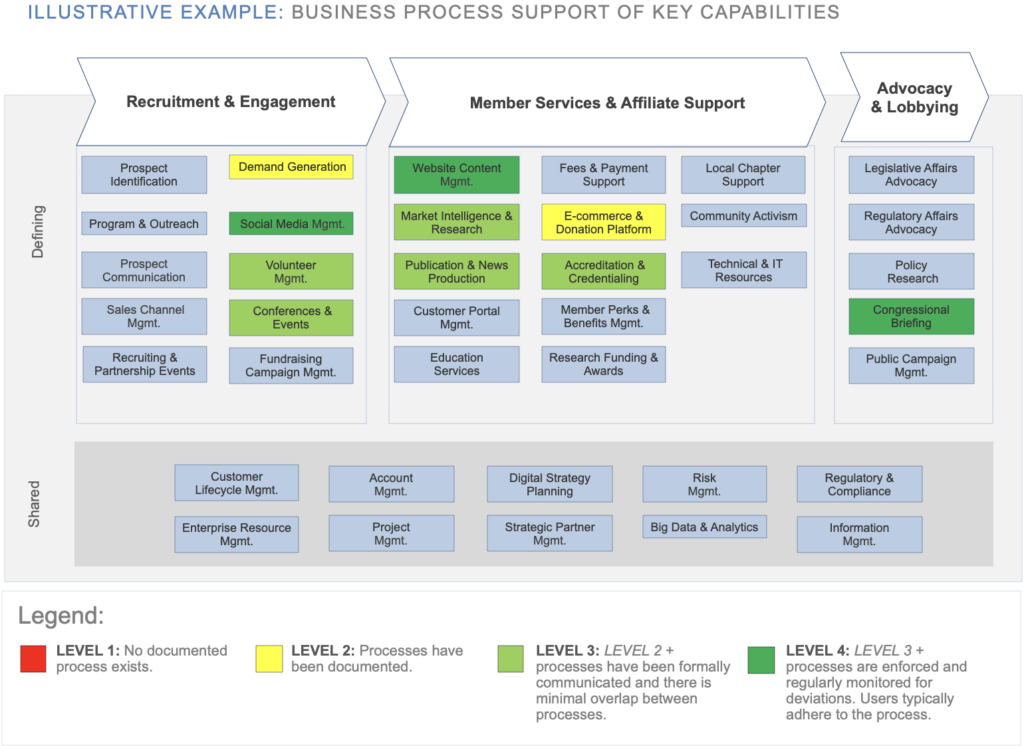
Step 7: Determine the availability of software infrastructure.
Do you have the right software tools and infrastructure to develop and deliver the elements and actions through a value stream? Is there any fragmentation, information bottlenecks, or disintegrated data processes? Or is your technology seamlessly integrated?
Map out your value stream networks in a flowchart. Your value stream network should connect your software infrastructure, people, and processes through a unified information highway.
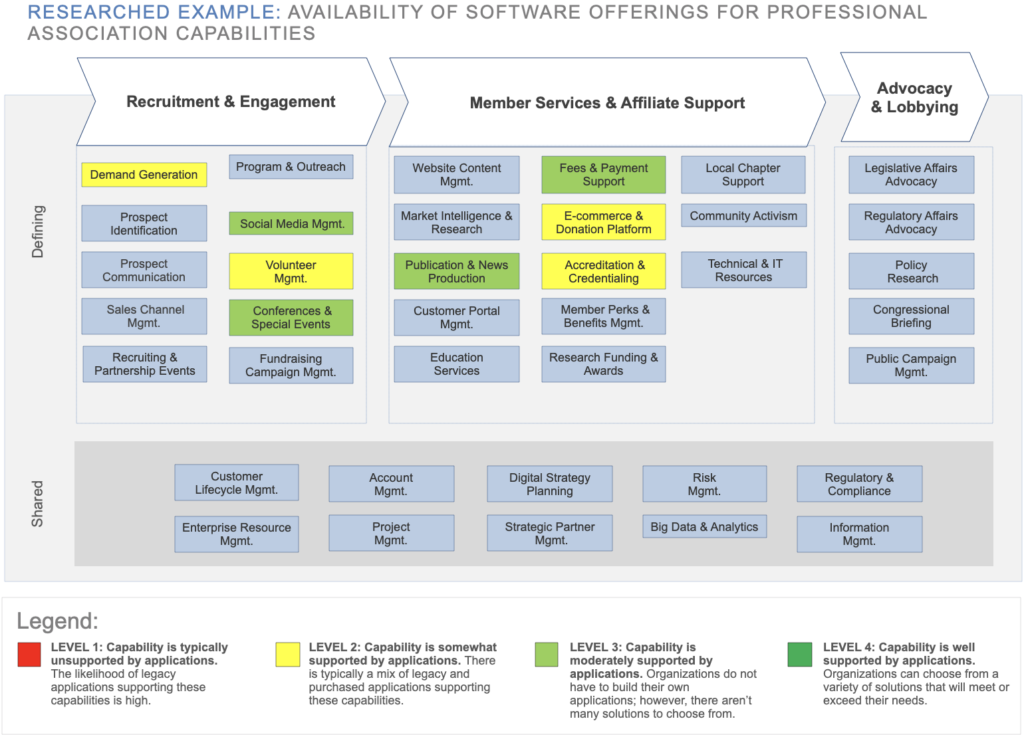
Optimizing your software infrastructure through your value stream network is vital for creating an integrated digital experience for your members and ensuring data is readily available for decision-making.
Value-to-difficulty analysis allows you to focus on strategic capabilities and flow elements within the value stream that provide the most value relative to the difficulty level.
The value level is based on strategic objectives and the alignment of key capabilities to these goals. Whereas difficulty is based on effort and availability of skills and expertise.
Completing this analysis puts your capabilities into four buckets indicating priority level and where to focus your IT investments:
- Prioritize
- Deprioritize
- Be selective
- Reconsider
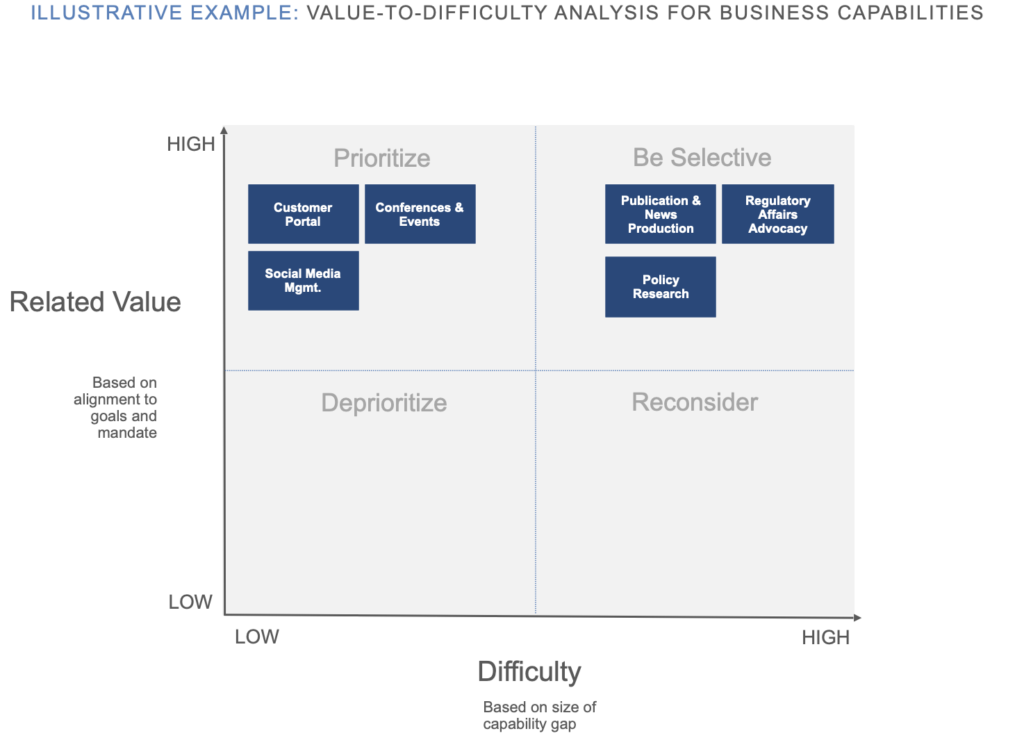
Essentially, this value-to-difficulty graph tells you to:
- Prioritize high value, low difficulty capabilities.
- Be selective with high-value capabilities with a high level of difficulty.
This analysis is based on a strategic investment-based model. It forces you to transition from a purely economic, cost-based model to an orientation focused on product/program operation. In other words, it shifts the objective from project to program management).
During your analysis, pay extra attention to capabilities contributing to a “network effect.”
The network effect is a self-reinforcing cycle or positive feedback loop. This phenomenon happens when each new user/member of a service or product increases its value.
Just think about Google and its network effect. When people first heard about the search engine, word-of-mouth spread quickly. This hype caused more people to use the search algorithm, making it even more valuable. And as a result, it drew in new users at an exponential rate. This 'social proof' concept demonstrates the exponential growth power of the network effect.
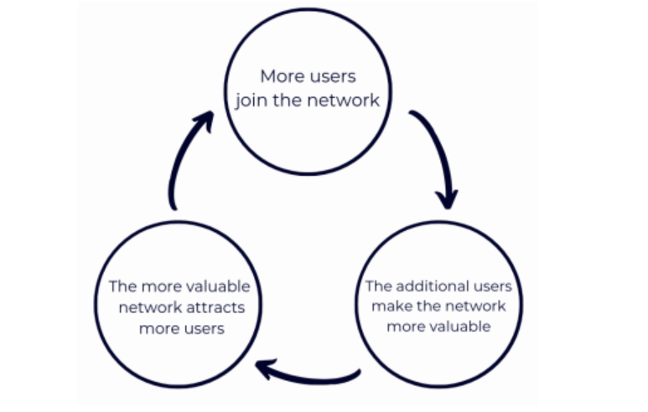
The impact of this network effect may start slowly, but like exponential progress, grows stronger each day. As such, capabilities adding to value streams with network effect traits should be put in the high-priority bucket.
Step 9: Create an IT strategy roadmap.
The final step in the cycle of value stream mapping and optimization is to map out the short-term and long-term strategic IT roadmap. This strategic roadmap should be incremental to maintain the stability and proliferation of the value stream.
Specify priorities for each quarter in years one, two, and three years. This IT strategy roadmap should be revisited on an ongoing basis as your strategic objectives, value streams, and IT programs evolve down the road.
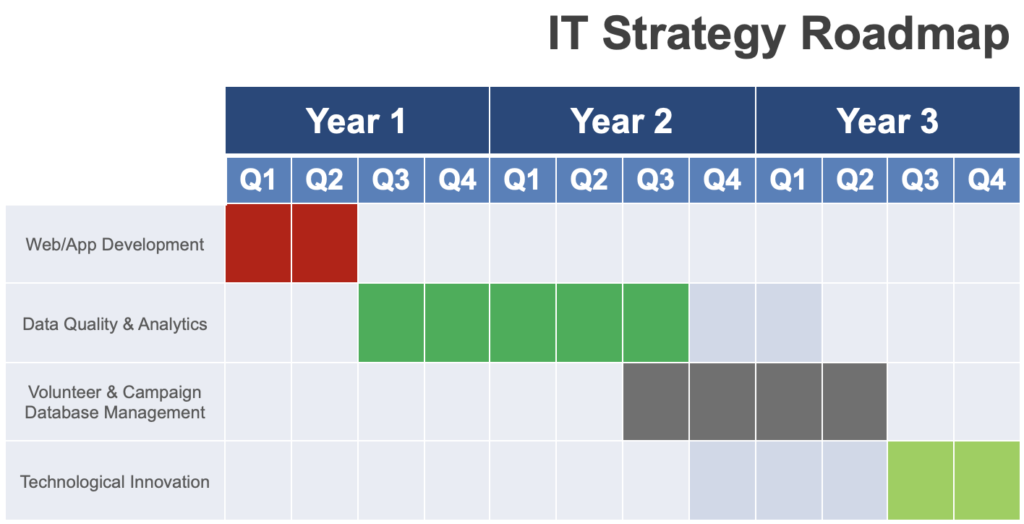
How does value stream mapping benefit associations?
Value stream mapping allows you to develop a unified and validated view of key business capabilities as they align to strategic initiatives, investments, and overall strategy.
Digital transformation boils down to process and operational efficiency. Through value stream mapping, you can point to places in your process and organizational structure that need optimization. It also points to unnecessary flow elements that are not in alignment with your strategic plan and objectives.
Value stream mapping and management increase the speed of flow elements through the value stream, allowing you to capitalize on new opportunities and adapt to change.
By gradually improving your processes and optimizing the way your teams work, VSM helps enhance the quality of each value capability and furthers the culture of innovation within your organization. It powers data-driven decision-making on how to best allocate spending and improve flow elements to deliver the most value.
Value Streams and Digital Transformation
In the age of disruption, value stream mapping is the ultimate playground for your digital transformation and long-term success.
At the core of all digital disruption is the rate of innovation and uptake. New software developments and systematic, process-level change initiatives are being adopted faster AND have a greater impact in less time than ever before.
With these two megatrends (digital transformation and adoption) powering ahead, changing user expectations are inevitable. Just like the ever-present threat of displacement from tech-driven competitors and business models.
All this disruption has caused a ‘digital divide’ or ‘technochasm.’ This divide is continually deepening, separating trailblazers with the conviction and foresight to leap at new opportunities from those doomed to fall behind. And this growing divide isn’t slowing down anytime soon.
Digital transformation marches forward 24 hours a day, regardless of supply chain obstacles or pandemics. Just look at what happened last year. A record number of inventive, “unicorn” organizations enjoyed incredible success, while many others became obsolete or suffered high turnover.
In order to compete, high-conviction associations must continuously assess and align their value streams, key business capabilities, and IT processes to a strategy map or strategic plan.
Ready to kick-start your innovative value creation journey and prepare your flowcharts? Get in touch with us. Let’s work together to improve flow through your value stream networks, add even more value for your members, and get you on track to achieving your goals.



